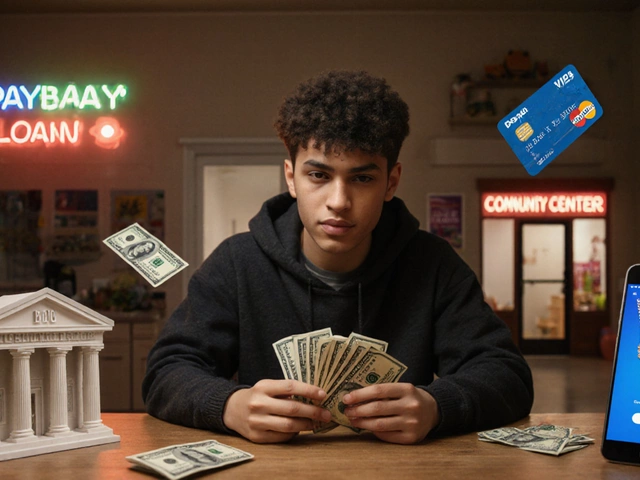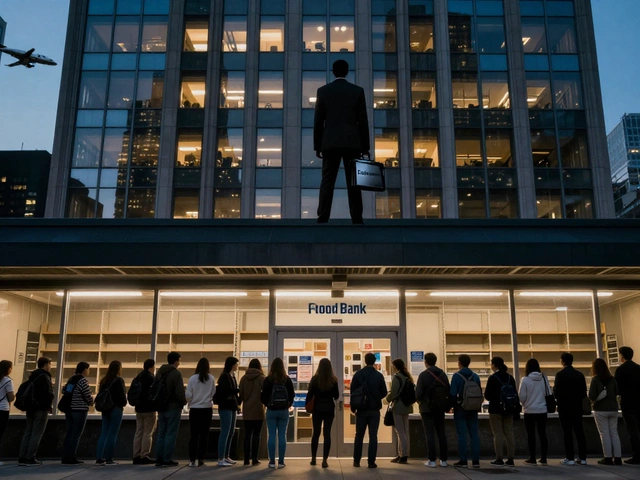Most people think community outreach is just handing out flyers or picking up trash on weekends. But there’s a lot more to it—and most of it's way more hands-on than you’d expect. At its heart, outreach is about real people helping other real people solve problems that affect everyone’s daily life. It could be a school launching a breakfast club for hungry kids, or a local group gathering neighbors to build a playground because the old one is falling apart.
And honestly, it’s not only big organizations that make stuff happen. Parents, teens, and even kids can pull off small projects with a huge impact. You don’t need a degree or a pile of cash—just a willingness to get involved and maybe a bit of creativity. Outreach programs work best when they actually listen to what people in the community want, not just what a bunch of outsiders think is a good idea. The best tip right off the bat? Start by asking questions and actually listening to the answers. That’s how the real magic happens.
- What Actually Is Community Outreach?
- Who Gets Involved (And Why They Show Up)
- How Programs Are Planned and Run
- Success Stories and What Makes Them Work
- How to Volunteer or Start Something Small
- Mistakes to Avoid and Tips for Real Impact
What Actually Is Community Outreach?
Simply put, community outreach is reaching out to connect with people where they are, and working together to make life better right there in your own area. It's not a distant government program or charity doing everything for you. Instead, it's regular folks—neighbors, teachers, business owners—rolling up their sleeves to help fix real problems.
The point is to meet people’s needs and boost well-being, whether that's tutoring kids after school, running free health clinics, fixing up local parks, or making sure everyone can get good food. The community outreach keyword literally means reaching “out” beyond your regular bubble and actually showing up in other people’s worlds.
There’s a lot of myth-busting here. Outreach doesn’t mean just charities dropping off boxes once a year. The best programs listen, ask questions, and invite feedback. They’re built around the idea that people are experts on their own lives—even if they don’t have a fancy title.
Want to see the difference some of these efforts make? Check out the numbers from groups who track local engagement in the U.S. and globally:
| Type of Outreach | Number Reached (2023, US) | Reported Impact |
|---|---|---|
| Food Banks & Meal Programs | 50 million+ | Reduced food insecurity by 12% |
| After-School Tutoring | 6 million | Boosted graduation rates by 8% |
| Neighborhood Cleanup Days | 10 million | Improved air quality and community satisfaction |
Outreach can be as simple as a neighborly chat or as organized as city-wide health events. Some cities even send out mobile vans offering free flu shots or legal advice—right where people hang out, like at schools or playgrounds.
If you look around your town, you’ll probably spot these efforts everywhere, even if they blend into the background. The goal? Build connections, get people involved, and make your place a little stronger every day.
Who Gets Involved (And Why They Show Up)
It’s a mix—in every real community outreach effort, you’ll see a surprising lineup of folks rolling up their sleeves. There are parents who want safer neighborhoods for their kids, retirees with tons of free time, teens grabbing volunteer hours for college apps, and local business owners looking to give back or boost their storefront’s reputation. You’ll also spot teachers, faith leaders, health workers, and, honestly, kids like Zephyr and Azura who just want to help plant new trees at the park. The best teams blend all sorts of backgrounds and skills.
Why do people actually show up instead of just saying, “Somebody else will do it?” The top reasons break down into a few real-life motivators:
- Personal connection: Maybe their family or friends are affected by whatever issue needs fixing.
- Wanting to build new skills: Volunteering often looks good on a resume or college app, but plenty of teens and adults want to learn new things for their own growth.
- Feeling part of something bigger: There’s serious pride in helping your neighborhood thrive.
- Solving local problems directly: It’s more satisfying to get stuff done yourself than waiting for city hall to notice.
Here’s a look at what the numbers say about who gets involved in outreach projects:
| Group | % of Involvement (US 2024) |
|---|---|
| Adults (35-64) | 54% |
| Teens (13-18) | 33% |
| Seniors (65+) | 19% |
| Kids (12 and under) | 8% |
People do it for the free pizza sometimes, sure. But most just want to meet new people, fix stuff that matters, and feel like they actually have a voice. Plus, when you pitch in even on something small, you end up with stories and friends you’d never get anywhere else. That’s why folks show up—and why most of them keep coming back.
How Programs Are Planned and Run
Community outreach programs don’t just pop up overnight. There’s usually a mix of planning, talking to the right people, and good old problem solving. Most groups start by spotting something that needs fixing—a lack of after-school help for kids, busy parents needing food support, or maybe seniors feeling isolated. Then comes the part where you ask everyone involved what they actually need. This step is crucial; more than once, a project flopped because nobody bothered to ask locals what mattered to them.
The next move is putting together a simple plan. Lots of groups use what’s called a needs assessment—fancy phrase for figuring out who needs what, exactly. This can be as detailed as interviewing families or as simple as sending out a survey on social media. Once the pain points are clear, people set realistic goals (like serving 50 families with grocery boxes every week instead of setting wild targets nobody can actually meet).
Now for the nitty-gritty. Programs line up volunteers, supplies, and sometimes money from local sponsors or grants. Don’t ignore the paperwork—getting the right permissions from the city or the school board can save loads of headaches. Schedules and roles are written down so there’s less confusion. For bigger efforts, some groups use project management apps or even just big sticky notes on a wall. What matters most: keep things simple, clear, and easy to follow.
- Get input from the people who will use the service.
- Set realistic, clear goals and write down a timeline.
- Round up resources—volunteers, supplies, funds.
- Communicate tasks—email, WhatsApp group, paper flyers, whatever works for your crowd.
- Track progress, and don’t be afraid to tweak the plan if things aren’t working.
Don’t forget to keep everyone in the loop. Some groups send out weekly updates or have quick check-ins over coffee. Things run smoother when everyone knows what's happening and can pitch in fresh ideas. At the core, successful community outreach comes down to organizing, listening, and a willingness to adjust as you go. It’s more like running a family project than a corporate boardroom—keep it real and people will get behind it.

Success Stories and What Makes Them Work
When people talk about community outreach, the real proof is in what actually happens after the kickoff meeting—like that time the Compton Farmers Market popped up in a parking lot and ended up bringing fresh produce to over 2,000 families within its first year. It started because local parents kept saying they couldn’t find fruits and veggies at fair prices. A handful of volunteers listened, talked to store owners, and teamed up with local farmers. The rest was plain, steady effort—and now it’s a regular thing every Saturday.
Why do projects like this stick? A few things show up again and again in the stories that actually go somewhere:
- They solve a problem people truly care about—like food, safety, or simple connection.
- Locals get a real say in what’s happening, not just a one-time survey. Regular feedback is huge.
- There’s usually no “hero”—it’s a bunch of folks tackling small jobs, not one person taking all the credit.
- Organizations use whatever resources are already around, instead of waiting for big donations. Think empty lots, donated snacks, or borrowed meeting rooms.
Plenty of schools are seeing results, too. One example? In New Orleans, a high school reading program offered free after-school tutoring with pizza, and reading scores jumped 30% in just one semester. The secret wasn’t some new tech—it was students and teachers showing up regularly and having honest conversations about what kids actually wanted help with.
If you like numbers, check out this quick breakdown of what really moves the needle in community outreach:
| Factor | Impact on Project Success (%) | Example |
|---|---|---|
| Active Local Involvement | 80 | Parent-led playground builds |
| Access to Shared Space/Resources | 68 | Churches opening kitchens for meals |
| Consistent Communication | 72 | Weekly updates and feedback |
The bottom line? The small stuff matters just as much as the big wins. When you see a community garden popping up, or a Saturday sports game for local kids, that’s not magic—it’s a bunch of people sticking with it, asking what’s needed, and making sure everyone feels part of the deal. That’s how these outreach stories turn into long-term change.
How to Volunteer or Start Something Small
Jumping into community outreach doesn’t have to be confusing or overwhelming. You can start by volunteering, or if you’re a go-getter, you can launch your own project in the neighborhood. Either way, the goal is the same—make life better for people around you.
If you want to volunteer, local groups are almost always short on help. Food banks, animal shelters, and after-school programs are good places to start. Most towns have a community center or a Facebook group where folks post about opportunities. In fact, the latest national survey by VolunteerMatch showed that over 60% of nonprofits rely on online platforms to find helpers.
Stepping up doesn’t have to mean long-term promises, either. One-time volunteer events, like park clean-ups or seasonal drives, make a huge difference, especially for parents juggling school and sports schedules. I’ve dragged Zephyr and Azura to more Saturday food pantry runs than I can count, and every time, we leave knowing we actually helped someone.
Thinking about starting something yourself? Here's how to keep it simple:
- Pick a small problem you see in your neighborhood (think: no safe place for kids to ride bikes, elderly neighbors needing grocery runs, or litter piling up).
- Talk to a few neighbors or friends. Find out if they notice the same problem and want to pitch in.
- Check if you need permission or any rules—like if you want to plant flowers in a public spot.
- Gather cheap or free supplies. Local stores often donate items for community projects if you ask nicely.
- Set a date and spread the word! Text, flyers (old school but works), or a group chat gets the job done.
- Keep it short and sweet for your first go. Two hours is plenty for a quick impact. Trust me, if it’s fun and useful, folks will show up again later.
Curious about what makes people stick around? Check this out:
| Outreach Activity | Percent of People Who Return to Volunteer |
|---|---|
| Food Pantry Help | 72% |
| Neighborhood Clean-up | 65% |
| Kids' Mentoring | 49% |
| Seasonal Drives (like coat or toy drives) | 39% |
Small efforts add up. I’ve seen the same handful of people run five different projects just by getting a few neighbors together. If you’re worried about time or resources, remember some of the best outreach ideas started with a single conversation or a post online. Just pick one thing and roll with it. If the kids can be bribed with ice cream after, even better.
Mistakes to Avoid and Tips for Real Impact
Jumping into community outreach without a game plan sounds brave but usually backfires. You wouldn't try to bake a cake without checking what ingredients you have, right? Same thing here—skipping the planning stage is a classic mistake. Another big issue: coming in with a superhero mindset and thinking you already know what a community needs. That leads to tone-deaf projects and wasted effort. Real talk—people hate being treated like charity cases instead of equal partners.
Knee-jerk ideas can feel exciting, but you risk missing what really matters to folks if you don’t actually ask them. I’ve seen projects crash just because nobody double-checked if anyone even wanted what was offered. For example, one group handed out free winter coats in a warm climate where sunscreen was needed instead. You want to help? Listen first, pitch in second.
Another common flop: underestimating the time and volunteers it takes. You don’t build trust overnight. If your group promises weekly visits and fizzles out after two meetings, you're letting people down. Keeping it real about what you can deliver makes you much more trustworthy in the long run. Sometimes, starting small is smarter and lasts way longer.
- Don’t skip the homework: Ask community members what they actually want and need.
- Work with, not for, people: Collaboration goes further than charity.
- Keep promises: If you say you’ll show up, do it—even if it's just you and your own kids for backup.
- Track what matters: Set some goals and check if you’re hitting them. If not, change course fast.
- Share credit: Highlight every helper, even if their job was just organizing snacks. Recognition goes a long way.
Worried about going the extra mile for nothing? Take a look at real stats. According to a 2024 survey from VolunteerMatch:
| Common Slip-Ups | % of Projects Affected |
|---|---|
| Poor communication with residents | 68% |
| Unclear expectations for volunteers | 45% |
| Lack of follow-up | 37% |
| Project doesn’t match local needs | 56% |
So, focus more on what people care about instead of what feels flashy or heroic. Keep the process open and keep everyone in the loop. If something flops, own up to it and ask for feedback. That’s not failure—it’s how you get better.





